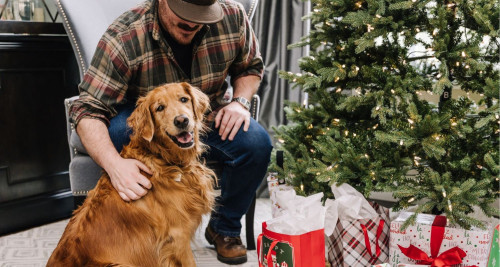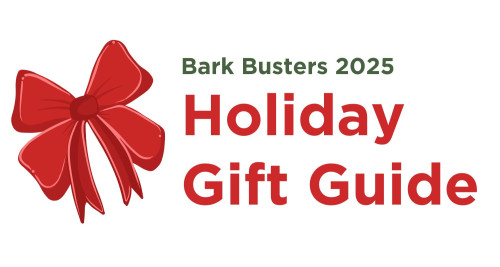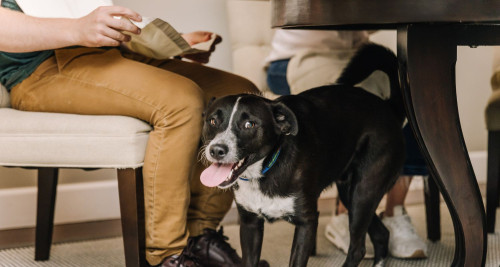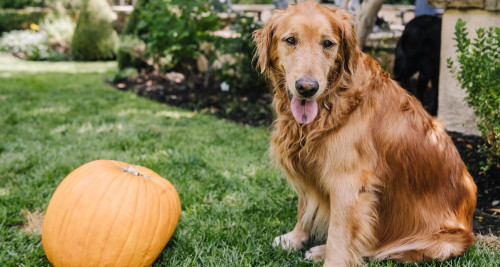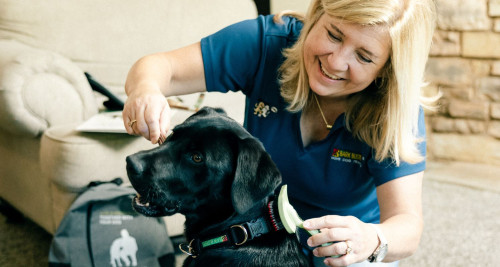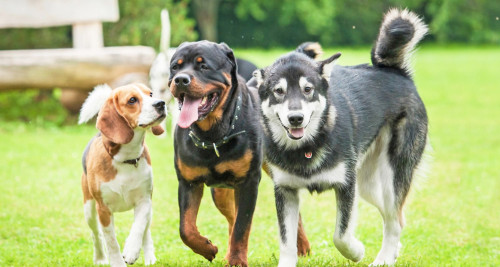Pomeranian
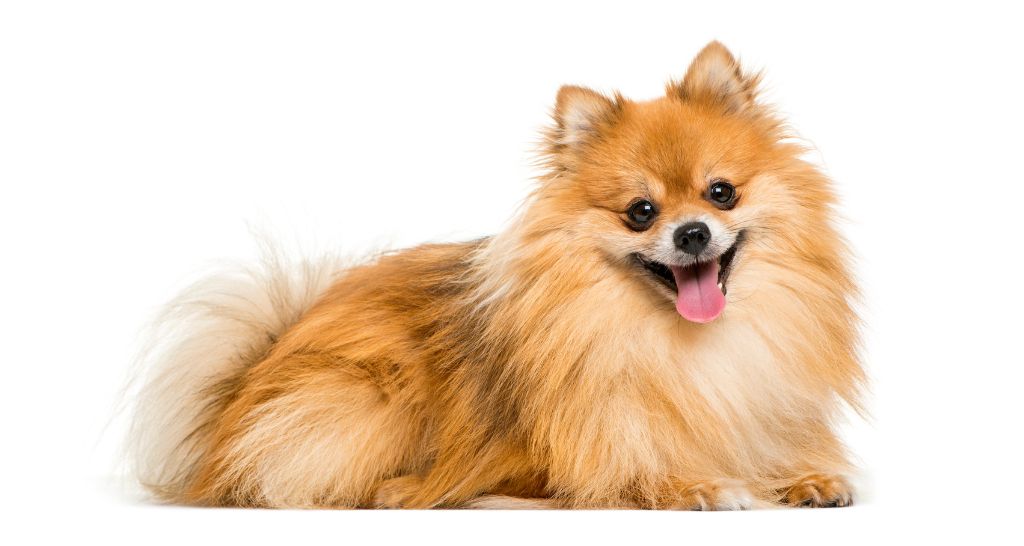
Breed Traits and Characteristics
According to the American Kennel Club, here are some breed characteristic you can find in Pomeranians.
- Height
6-7 inches
- Weight
3-7 pounds
- Life Expectancy
12-16 years
- Coat Type/Length
Double/Long
-
100 Affectionate with Family
-
60 Good with Young Children
-
60 Good with Other Dogs
-
60 Trainability Level
-
60 Energy Level
-
80 Barking Level
-
40 Shedding Level
-
20 Drooling Level
History
The Pomeranian takes its name from Pomerania, a geographic area located in what is today northern Poland and western Germany. It was here that experts believe breeding and cross-breeding of large sled dogs created the smallest member of the Spitz (German for “sharp,” referring to their typically pointy noses) family – their cousins include Norwegian Elkhounds, Samoyeds, and the Malamute.
Pomeranians were very popular with 19th-century royalty, who were responsible for altering some of the breeds features and size. Queen Victoria was an especially big fan of the diminutive Pom, showing six of her own at the 1891 Crufts dog show. Over time, breeders further cemented their lush coats, small ears, and plumed tails, along with their short legs, pointed snouts, and big personalities.
The Pomeranian
The Pomeranian (or Pom, for short) is an unfailingly popular dog that consistently ranks in or around the American Kennel Club top 20 breeds. These compact, cuddly, and attractive canines – colloquially nicknamed “The Little Dog Who Thinks He Can” – combine high intelligence and a fearlessness belying their diminutive size with a distinctive lush coat and almond-shaped eyes. While they are active dogs, their small stature means they are comfortable in city or suburb, where they are easily exercised with vigorous indoor play or short jaunts outside.
Pomeranian Breed Facts
Physical Characteristics
Pomeranians are smaller dogs with thick, lush double coats, short, sturdy legs, a curling tail, and a pointy face. Their ears (inherited from Arctic breeds) are short, designed to limit loss of body heat. They are prone to knee issues, including luxating patella – a knee or patella dislocation, sometimes identified by a clicking sound in the knee area. Poms are also prone to tracheal collapse and should never be walked or trained on a collar or anything that places pressure on their trachea. It is vital to confirm their harness fits correctly.
Personality & Temperament
The Pomeranian has a big personality that belies their size. As a result, they can engage in conflicts with other dogs, asserting their perceived leadership status. This can place them at risk of being harmed by a larger breed.
Occasionally, this can lead to behavioral issues around the home. Poms will often want to be first to answer the door; they will bark at noises they hear, and they tend to want to run the entire household. Because of their cuteness, many people allow them to get away with otherwise unacceptable behavior.
Their tendency to bark can be problematic for apartment and condominium dwellers. They are very trainable, however, and with some determined management and ongoing education, they can become loving pets. We recommend basic training for all Poms – early, consistent training pays large dividends when it comes to avoiding future behavioral issues.
Breed Traits
Class
- Toy Group
Color
- Blue, Black, Black & Tan, Brindle, Cream, Merle (a recent addition by breeders, this distinct mottling of colors has seen a rise in deafness of the breed ranging from mild to severe), Orange, Sable, Spotted, White
Size
- Small
- Height: 6-7 inches
- Weight: 3-7 pounds
Other Traits
- Plumed tail that curls proudly over the hind quarters
- Short ears, designed to maintain body heat
- Fringe of feathery hair that adorns their short, study legs
Life Expectancy
- The Pomeranian has a life expectancy of between 12 to 17 years.
Training Your Pomeranian
Tips for Potential Owners
- While Poms are generally healthy, they can be susceptible to health conditions like luxating patella, hypothyroidism, collapsing tracheas, congestive heart failure, seizures, and alopecia X.
- Pomeranians can get their exercise in small spaces, making them excellent dogs for apartment and city dwellers.
- Poms have high activity levels and do best when not left inactive for long hours.
- If you are thinking of purchasing a Pomeranian, it is important to source from a responsible breeder who is breeding for not only looks, but health and temperament as well. Rescues are also great options for prospective Pom owners. Contact your local Bark Busters trainer today to learn about great breeders and rescue organizations near you!
- All dogs need a special place to call their own. By selecting a place for yours to eat and sleep away from high traffic areas of your home, you can set good habits early in its life. Prevention is far more preferable to a cure – early basic obedience training is vitally important to ensure your Pomeranian understands and follows your rules.
We are standing by to help you develop a consistent, compassionate approach to good behavior for your Pomeranian. Learn more about our services and schedule an appointment with one of our trainers today!
Connect with Us!
Need help training your Pomeranian? Call 1-877-500-BARK (2275)or enter your zip code.
Bark Busters Trainer Jeff Drier on the Pomeranian
As The American Kennel Club aptly states, “the Pomeranian combines a tiny body and a commanding big-dog demeanor.” Most of the problems we see with Pomeranians as Bark Busters® trainers are due to people treating them not as big dogs, but as babies. We’ve seen Pomeranians who refuse to walk – with or without a leash – because they have been carried so much. We have seen them bark nonstop, almost like a child having a tantrum, when they don’t get their way.
It’s important to understand that Pomeranians, like all dogs, can view themselves as being big, like a German Shepherd. Most people would not carry around a German Shepherd, but they think nothing about scooping up a Pom, nestling it in the crook of their arm, and carrying it every place they go. As a result, Poms can become demanding and protective of the person catering to them. They become stressed and act out, causing their human family stress, and creating an ongoing vicious cycle.
Fortunately, Pomeranians are typically smart dogs who aim to please. With a few modifications to their owners’ behavior, things can change for the better. Take Princess, a beautiful, professionally groomed Pom: she was the pride and joy of wife Susan – and the bane of her husband Peter.
Susan had adopted Princess before meeting Peter, and initially she was a cute, funny, and endearing dog. Once Susan and Peter moved in together, however, Princess became more protective of Susan. She would sit directly beside Susan or in Susan’s lap, growling and baring her teeth if Peter approached. The same thing would happen when Susan was in bed and Peter came into the room. Finally, after months of stress, they reached their limit when Princess bit Peter. Both Susan and Peter agreed that if Princess’s behavior didn’t change, she would need to be rehomed.
Fortunately, Susan and Peter called Bark Busters. Our trainer, Cathy, met with them to learn about Princess’ history and relationships with Susan and Peter. Once Cathy understood the causes of Princess’s behavior, she explained them to Susan and Peter, then developed a program to create positive changes.
Cathy coached them through some exercises and Princess responded beautifully. She preached consistency in practicing the exercises, as it would likely take a few weeks to make concrete changes. Susan and Peter were excited and encouraged by Princess’ responses to early training and made regular commitments to practice the exercises, vowing to keep Cathy posted about their progress.
A couple of weeks after that initial session, Cathy received a report from Susan and Peter that Princess was like a different dog. She was no longer growling or snapping at Peter and she was much more relaxed. As a result, Susan and Peter were more relaxed and happier as well!
If you are having behavioral issues with your Pomeranian, your local Bark Busters trainer is standing by to help. Our trainers can assist in establishing a pattern of consistency, resolve any and all issues, and help you nurture a relationship with your Pomeranian built on mutual understanding, trust, respect, and love.
Pomeranian Grooming
While grooming a Pomeranian is easy, their luxurious double coat – a soft, dense, thick undercoat, with a straight (and much longer) outer coat – requires daily attention. A once-a-week brushing using a pin brush and slicker brush can help further alleviate any issues and keep hair from matting. Tangling can occur during the Pom’s twice-yearly undercoat shedding, and clipping is advisable every couple of months to further help manage the coat; because of their active lifestyles, their nails should be cut short as well. The American Kennel Club also advises owners find a groomer to perform a full groom every four to six weeks.
Tips for Every Dog Owner
Hear from Bark Busters Clients Who Have a Pomeranian
Ready for a Better-Behaved Pom? Fill Out Our Form and Explore the Benefits of Professional Training!
Enter your zip code and send in this brief form. We’ll contact you within 24 hours to learn more about your dog’s needs. Skip the guesswork of group classes—get tailored in-home support instead.
- 99.7% 4 or 5 stars 99.7% rate their experience with Bark Busters as 4 or 5 out of 5 stars.
- 99.6% Would Recommend 99.6% would recommend Bark Busters to their friends and neighbors.
- 99.5% Dog Responded 99.5% think their dog responded well to the training.
Need Dog Training Assistance with Your Pomeranian? Find Your Local Trainer Now!
CALL TODAY 1-877-500-BARK (2275)
